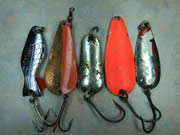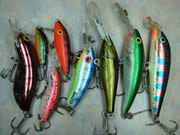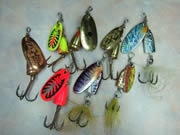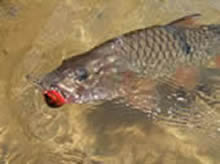
Luring Sebarau (Hampala Barb)
Dedicated sebarau anglers are very particular about the lures they choose to use because sebarau themselves can be very fussy about the lures they choose to eat! So how do sebarau anglers know what lures they should lug to their fishing grounds, as there are so many types of lures on the market these days.
To make it more complex, there are so many types of lures out there that can catch sebarau, but not necessarily consistently. I think it can be safe to say that “all” lures in the market can catch sebarau at some time or another. It is a fact that if you throw a lure or a bait at a fish often enough, there will be a day it may take the “bait” or in this case the lure. I have seen many, many different varieties of lures catch sebarau, but I have also noticed that some types of lures catch the sebarau more regularly than others. Then among those there are some that really shine in most conditions, and there are others that work particularly better and more often in certain localities and conditions.
This is probably what makes sebarau fishing fascinating, knowing the lure to use to achieve good results. However to throw a spanner into the works, what works one day may not work another day in exactly the same spot. Knowing why this happens helps if the sebarau is understood: their forage, habitat and even their temperament.
Probably the best lure to use to get the sebarau to bite is one which it looks like something they would eat. That of course means chances are higher that they would eat it, unlike a lure t hat looks nothing like food to them. This is especially so when they are in the feeding frenzy mode. So let’s look look at that first.
The times when you see sebarau in schools chasing down baitfish, often during the rainy season near river mouths when there are shoals of their forage around, are when they can become finicky. The sebarau will be so focused on eating the forage that is shoaling in quantity in the area that they will ignore any lure that is unlike the shoaling baitfish in appearance and size. That is when you need to match the bait fish. The occasional lucky hook up among hundreds of feeding sebarau is basically just that, plain luck. Probably they hit the lure more based on instinct as it passed in front of the fish. However at times like these, most sebarau tend to lose their instinct of hitting anything that moves but are very target specific.
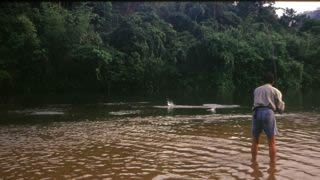
Mostly when they feed frenziedly in massive schools at times like these, the forage often tends to be small baitfish, very small baitfish. They are often as short as only a centimetre in length. That is why there are many stories of frustrated anglers surrounded by feeding sebarau and yet they were unable to get a single bite as the sebarau busily chased down baitfish all around them. The reason for their lack of hook ups is due to the fact the lures they were using were too big, or the smaller ones looked nothing like the forage.
Normally at such times, the fly fishermen with their small lure type flies do very well trumping the lure casting fishermen hands down as their small 1-2cm baitfish flies resemble the forage better than a hard lure.
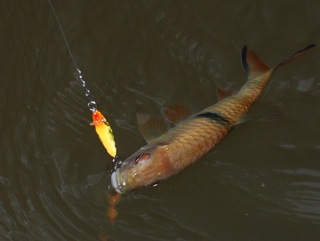 Anglers prepared with small 1-3cm crankbaits, spinners or spoons/metals can get a reasonable number of hits with these lures. Why I say reasonable is that the sebarau are still very discerning and they don’t necessarily gulp down any small lure. It still is hard work, with a lot of casting as the sebarau at times like these want lures that match the baitfish very closely. The profile, colour and action play an important factor.
Anglers prepared with small 1-3cm crankbaits, spinners or spoons/metals can get a reasonable number of hits with these lures. Why I say reasonable is that the sebarau are still very discerning and they don’t necessarily gulp down any small lure. It still is hard work, with a lot of casting as the sebarau at times like these want lures that match the baitfish very closely. The profile, colour and action play an important factor.
Only by being there and experimenting can the angler figure out what lure works for that particular frenzy. As these lure types are very very light, from a few grams to less than a gram, a light spin rod is the best choice of tackle to cast out these small and light lures. In addition fine lines are needed to allow the lure to travel any distance. Mono lines should be definitely 3kg or less and better yet use braided lines of 4kg or less for maximum distance. The spin fly technique also works well in casting out flies or ultra light lures. Therefore when encountering feeding frenzies like these where they are not taking regular lures, small or very small lures would probably do the trick.
Having expounded the benefits of small lures in this case, there was one time when the sebarau were seen feeding in a bay in a large river, and the hottest lure of that moment was a big broad copper coloured spoon. Only that spoon worked and no other spoon. Other spoons that closely resembled the successful one were tried but with no success. Some lures that were similar to the spoon in profile had some hook ups but were out fished by the hot spoon 15 to 1! In addition to the spoon, fly fishing with small 2cm flies were consistently catching sebarau too. These sebarau were probably feeding on two species of baitfish, the small tiny baitfish that sebarau had been found to feed on in the area and also bigger fish that were prolific in the same bay at that time, the river lampam.
From this we can surmise that there are cases where the sebarau can be very choosy in lure types they wish to hit, and it is probably because the size, profile, colouration, and the lure action resembles closest to their forage at that time.
At times other than feeding frenzies, temperament is a key factor of getting the sebarau to bite. They seem to attack based on movement. It is probably a combination of vibration and vision. Those who have kept sebarau caught from the wild in fish tanks would have noticed that the wild sebarau will only eat live fish. A dead baitfish dropped into the tank will be ignored. They will not even sniff at it, whereas a live baitfish will be instantly chased and snapped up. So long as the fish swims and darts around the sebarau will feed. Domesticated sebarau however have a very different behaviour and are used to feeding on pellets or static food, thus they are not a good example of the temperament of wild sebarau.
This is why I have yet to meet an angler who talks about sebarau gently taking lures. When they do try to eat a lure it is always taken with an arm shuddering bang! The sebarau instinctively homes in on a moving lure, whacking it hard before its quarry gets away.
Lure anglers need to make the most of the sebarau’s instinctive aggressive hits. When the sebarau are in the hunting mode, cruising the bankside, they often are indicated by their distinctive feeding splash. A cast into the vicinity followed by a quick couple of cranks will be quickly followed by a solid hit. In most places a generic sebarau type lure normally works well and consistently in these situations.
The generic sebarau crankbait probably has a body length about 5 to 7 cm with a flat sided profile and deep body, similar to the shad found in America, hence these lures are known as shad type lures. My favourite lure is the Tilsan Bass from Australia. A favourite of many old timers for sebarau is the Shad Rap from Rapala.
The minnow shaped crankbait works well for sebarau too as there are many small local baitfish (i.e. seluang) that have the minnow profile.
There are many varieties of crankbaits out there, but the consistent producers have strong vibrations. Lures with subtle vibrations do work, but lures that give solid hard and tight vibrating feed back to the angler seem to attract the sebarau’s attention more often. An added feature with lures that have a good solid action is that they can easily take heavier hooks, which are so necessary when going for sebarau, especially the big ones.
Many crankbaits originate from temperate countries and have light hooks. Our tropical fish tend to butcher these hooks so the small crankbaits need to have their hooks changed to beefier ones. The lures with subtle vibrations will have their actions dampened out by the heavier hooks, making them even less attractive.
It is also necessary to use sebarau crankbaits that can take speed. Good quality sebarau crankbaits are well designed and built, able to work well at low speed, and at high cranking speed they should swim true without spinning out of control.
The good old spinner is a forgotten sebarau lure nowadays. The fast spinning blade around a metal body is a proven fish taker around the world, and sebarau are among one of those that the spinner works well. In fact, my first ever sebarau was caught on a spinner. I am not sure why they work so well for sebarau but it could be their small size that fits the profile of a bait fish which entices the sebarau, or the shiny spinning blade that produces the vibration of an injured bait. Perhaps it is the combination of both features that make it so deadly.
Here in Malaysia the only quality spinners available I am aware of are by Blue Fox. Other quality spinners by Mepps, Rooster tails, Panther Martins also work well, but unfortunately I do not think that they have a regular distributor in Malaysia.
Any of the shiny blades, especially the gold and copper finishes, work well. Blades that are painted with red, pink, chartreuse or yellow fluorescent paint have always caught lots of sebarau. When going for small sebarau the size 00 or 0 spinners just keep bringing them in. As they are rather light, in the 1-3 grams range, they are best cast with light spin gear. When hunting for larger sebarau the size 1 to 3 spinners make it easier to cast, especially if baitcasting tackle is favoured.
The good old spoon is another “old” lure type that has seen its fair share of sebarau. It is not as popular today with the younger generation of sebarau hunters, but it is still a very good lure. Spoons vary in size greatly, from 2 cm to 10 cm, but probably the most ubiquitous size for sebarau would be the 4-5 range. Like the spinners, flashy silver, gold or copper finishing does well, as does finishing in bright red, yellow, orange and chartreuse colours.
The lighter or thinner walled casting spoons have the strongest thumping action. This hard side to side swinging of a spoon really attracts the sebarau. In fact, the crazier the action the better the success of the spoon. There was one variation of the spoon that was made by Rapala (Minnow spoon) but it is no longer available, that was very good for sebarau as it had this type of action. However only the smaller 1/4oz model caught sebarau regularly for us, unlike the larger 1/2oz model. There are many models out there, old and new designs that work. The well known Abu Island is a stalwart very old spoon that was and still is very successful. However it too is no longer in production.
Though I have mentioned spoons not in production that work well, there are still many spoon types out there that work well for sebarau. Recently I was fishing with a friend who was using a fish-shaped spoon called the Wobbler made by Halco that was successfully luring up the sebarau very consistently. Its hard wobbling action was clearly the reason why the sebarau liked it so much. Another spoon type from USA that has worked well for me in the past is the DareDevil, well known for its red and white finish. It too has a hard hitting wobble. One thing in common with all these successful spoons is that they must be relatively small and light. The heavier spoons produce less of a strong wobble, than the lighter spoons.
All these lures have one thing in common that make them successful sebarau lures - Vibration. The spoons and crankbaits give a thumping vibration and spinners give off a higher frequency vibration. Whatever the case, it seems that vibration is the key for a successful sebarau lure!
Conservation
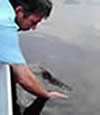
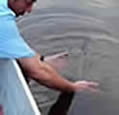
We need to protect and conserve our resources by practising catch and release of our sportfish and protecting the habitat of our fishes.
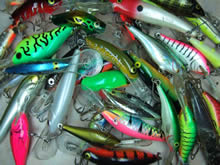
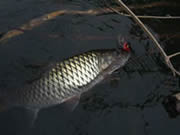
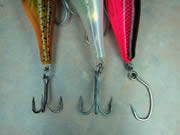 Hardcore sebarau hunters upgrade their hooks. Often the standard hooks that come with the lures are meant for temperate more sluggish fish. The two lures on the right have had their hooks upgraded to a heavier treble hook and a stronger single hook.
Hardcore sebarau hunters upgrade their hooks. Often the standard hooks that come with the lures are meant for temperate more sluggish fish. The two lures on the right have had their hooks upgraded to a heavier treble hook and a stronger single hook.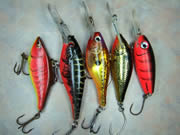 There are numerous “shad” shaped crankbaits on the market.
There are numerous “shad” shaped crankbaits on the market.  My favourite is the
My favourite is the 